Refractometers Or Hydrometers: Why The Latter Should Contain A Warning
Refractometers or Hydrometers
Why the latter should contain a warning
By: Justin Leoni of Reef Savers Aquatic Services
Introduction
Having been around saltwater aquariums for most of my now almost forty years, I’ve seen many gizmos and gadgets. I’ve seen a hobby that one was only for the most advanced aquarist become affordable and available to the masses because of the continued success of both professional marine biologist and the joint effort that the hobby community has put forth to educate. In this article I want to open your eyes if you currently use a hydrometer with your marine aquarium. So before I step into the actual math and pretty pictures that accompany this article, I want to share with you some experimentation and observations that I have done over the years now in regards to salinity and how it affects our systems especially that of reef systems but in general the overall effect has ramifications for even fish only or fish only with live rock systems as well.
Snails, everyone has snails or has at least tried to keep a snail at some point in a marine aquarium. What most people don’t know is they snails are extremely sensitive to changes in water parameters and should be acclimated just as you would coral. Do not be “that person” who says oh it’s just a snail and toss it in. Snails have very hard time breathing well when the salinity reaches 39.8 ppt or 1.030 SG in our home aquariums. When it reaches 40 ppt it starts to become fatal to snails, especially with Mexican Turbo species. Corals also turn brown in color with increased salinity and the reason for this is explained in the next statement.
The one observation that I made from my experiment with salinity was that once you reach 39ppt algae blooms, both green algae and brown diatoms. When I noticed this everything started to make sense to me, apart from my normal day job I moonlight as an aquatic service specialist specializing in saltwater reef aquariums. As part of my business we buy failing systems from people who can no longer afford or have the time required to keep their reef alive. When we come in we buy everything up, from the equipment to the livestock, you name it we put it on the bill of sale. Every system we have purchased and rehomed that was covered in algae so thick that you couldn’t see in the tank or the rocks were covered in hair algae and corals were being smothered to death all had one thing in common, their keeper used a hydrometer.
What Is a Refractometer
Well according to the dictionary it is “an instrument for determining the refractive index of a substance.” If you would like more information on refractometers and how they work see http://en.wikipedia.org/wiki/Refractometer for more information. So pictured here is a standard hand held refractometer that you can get from most online retail outlets such as Amazon or Ebay for around fifty US dollars. With that said you can see that this is not an investment that will break the bank, and honestly I cannot think of any one better purchase maybe other than a quality skimmer or salt (articles for another day) that you would purchase for the longevity of your aquarium!
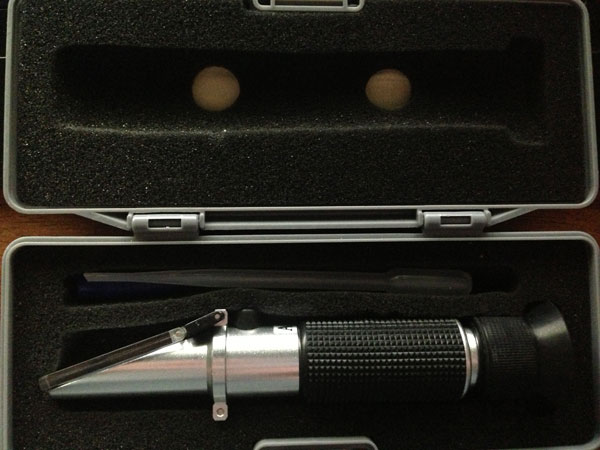
Now I will have to say this first and foremost, because when I first got into refractometers; I fell victim to the instructions which came with my shiny new toy. I have had many people ask me this question on forums and by private messages in various places. “The instructions said to use distilled water to calibrate it. I didn’t have any so I used RO water!” For me I personally keep distilled water around for its purity when making up calibration solutions for pH testers or TDS solutions etc. But let me shout this from the top of the mountain so everyone can hear me. Do not, again for emphasis, do not use distilled water or reverse osmosis water to calibrate your refractometer for saltwater aquarium use. You can buy a small bottle of perfect saltwater calibration solution for around five US dollars. And if you keep it tightly closed and in a cool dark cabinet or in another safe location odds are you would not have to buy more for quite some time as it only consumes two to three drops to calibrate your device.
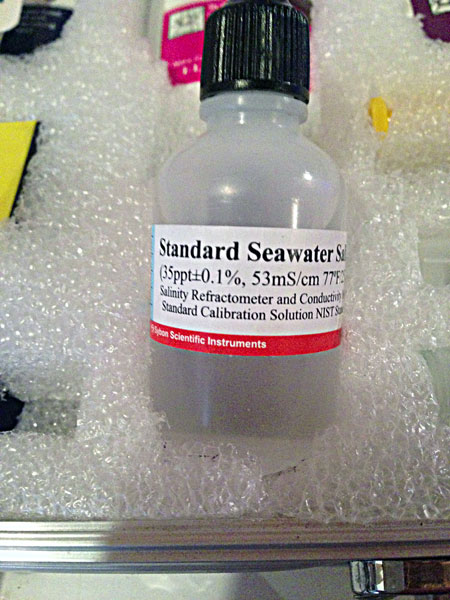
So for those of you who have never used a refractometer let me start by telling you that it is a very simple device to use. You simply place a few drops of water on the prism, lower the cover making sure that there are no air bubbles in the mix as they can cause light to diffuse improperly through it. You then look into the eye piece and you’ll see a chart similar to the image here. Looking at the right side of this scale you will see the common “Specific Gravity” numbers that we all in the saltwater trade are accustomed to. My particular unit reads from 1.000 all the way to 1.120. To read the SG of a particular solution simply look where the white meets the blue in the viewing area and thusly where that corresponds on the scale. When viewing your refractometer make sure that you are standing under a bright light as this will help clear up the line between refracted light and that of the light which comes straight through.
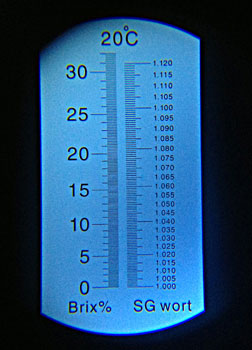
When calibrated with the solution as described above the following image is what you will see. If your refractometer is not reading 1.0264 (35 ppt) simply adjust the set screw with the jewelers screwdriver, which should have been provided when you bought your refractometer, until your scale reads like the image below:
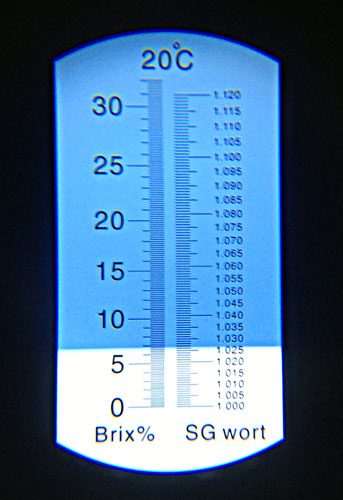
As you can clearly see my refractometer is dialed in perfectly at 35ppt or 1.0264 Specific Gravity.
Heads Up Comparison
So for this section of the article we are going to see actual photos taken by me all of hydrometers as well as the refractometer image as the control, all water was from the same reef aquarium. It should also be noted that the previous calibration image was done prior to testing to ensure that the refractometer was calibrated properly.
The following is our reef water viewed through the refractometer. This will serve as our control for all calculations which will follow with each hydrometer reading. It read right around 1.0255 which is about spot on considering I added about 5 gallons of fresh RO water the previous day for our weekly top off.

When you get your calibration solution it should come with a conversion chart similar to the next photo. Make sure you save this chart with the rest of your testing materials as it gives you a simple way to convert SG to salinity in ppt. Personally I keep it pinned to the wall in lab, but not all of us have rooms dedicated to the science aspect of our hobby, and if some of you are like my wife you don’t care about the geeky stuff, as she says “Just make it pretty to look at!”
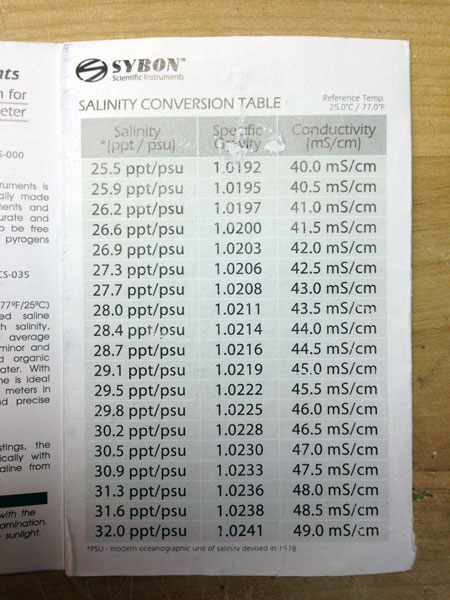
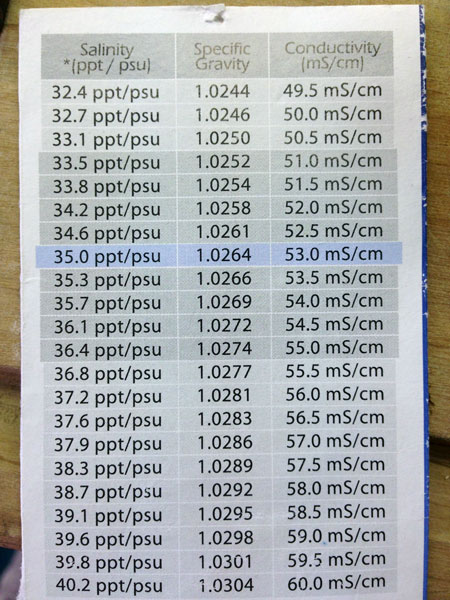 So using the charts above we can deduce that our salinity with our perfectly calibrated refractometer is 33.9 ppt or as the scale in the viewable pane told us; 1.0255 SG. But converting to ppt will make for easier calculations so we will stick with that.
So using the charts above we can deduce that our salinity with our perfectly calibrated refractometer is 33.9 ppt or as the scale in the viewable pane told us; 1.0255 SG. But converting to ppt will make for easier calculations so we will stick with that.
Here is the same water using a brand new Fluval Sea hanging hydrometer.
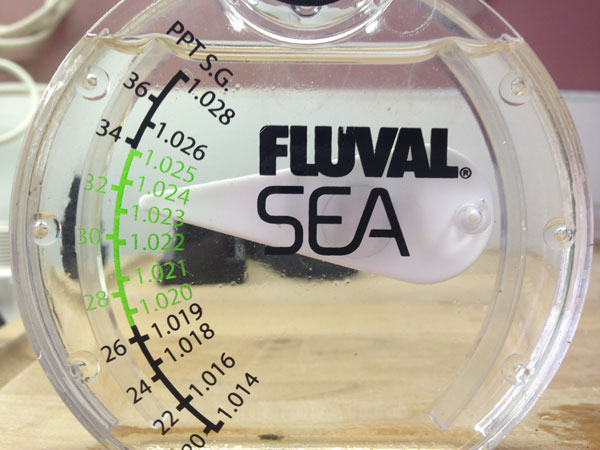
Clearly it is reading less than 32 ppt and the SG is probably around 1.0234 which according to our chart above comes out to around 31.1 ppt. Which if you were like me when I first started looking at numbers are probably saying to yourself that the PPT scale on this hydrometer is off and you are correct there is a direct mathematical equation for converting SG to ppt. I’ve double and tripled checked the numbers on the chart with the math and deduced that they are correct.
That means 1.0241 is 32ppt and thus as you see on this scale on the Fluval Sea 32 ppt falls below 1.024 and more in the range of 1.0238. So how can this be? Without going into too much science on specific gravity and boring you to death, I can tell you this; all hydrometers are calibrated to a specific temperature most of which are 25°C or 77°F as the temperature increases of your solution so does the ppt at the same SG reading.
An example SG reading of 1.0240 done at 25.5°C or 77.9°F actually has 32.08 ppt salinity. So just keep it in mind that odds are your hydrometer was calibrated for a temperature lower than were you keep your reef. I know most reefers these days keep between their systems 79°F and 81°F. So this should be your first warning to the inaccuracies of Hydrometers. So even if we discard the ppt math we clearly see that from our control SG is off by as much as 0.0021. This doesn’t sound like a whole lot but let us consider this; if you are like most beginners into the reefing hobby, you want to provide your corals and other inverts with the utmost quality care possible, and everything you read tells you 35 ppt or 1.026 SG for a reef aquarium.
So now using the above hydrometer we slowly raise our SG to 1.026. But remember it’s off by at least .0021 so adding that back in we are now up to 1.0281 and off the chart of what this hydrometer can actually display. Now if we take that to our conversion chart we will find that 1.0281 is 37.2 ppt at 25°C or 77°F. That being said you can clearly see how we are quickly closing in on the danger level. As your aquarium loses water due to evaporation unless you have an auto top off system you can see where you are now raising your salinity into the dangerous levels repeatedly week after week.
So let us take a look now at a free standing Instant Ocean hydrometer which is fairly new. Remember all of these photos were taken using the same system within minutes of each other so as to minimize any environmental changes in temperature.
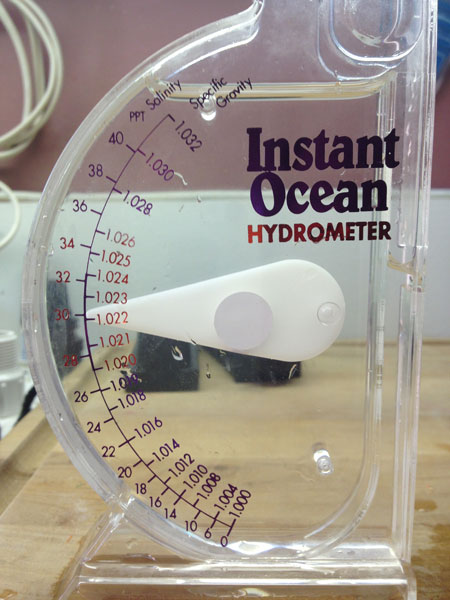
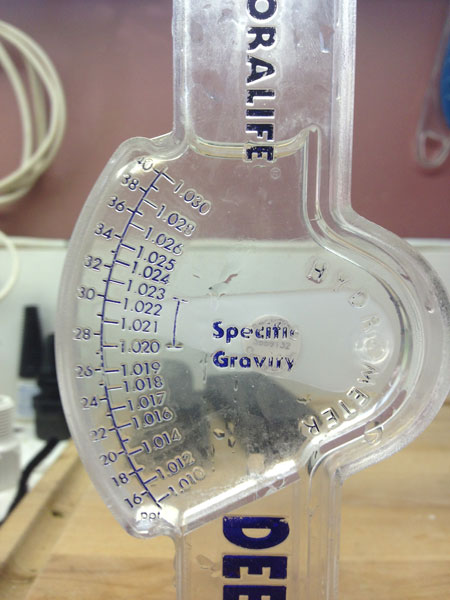
This one being older but well taken care of over the years still works just like the other ones and it is reading 1.0215 which gives us a difference of 0.0040 in SG. If you were to use this hydrometer to obtain 1.026 you would end up with death water of 1.030 and evaporation levels around 1.031.
Closing Arguments
Many people ask me how I keep such a pristine show reef with very little algae. I scrape my glass about once every two weeks because like all systems some algae is going to grow. I encourage macro algae in my sumps refugium area, I run a quality protein skimmer and GFO reactor. But even before I would give credit to any of those devices, I credit my use of a fully calibrated refractometer.
I find it amazing how I see people spend literally thousands of dollars annually on corals, fishes, skimmers, reactors etc. and only pay ten dollars for a hydrometer. Personally I think hydrometers should be illegal to sell, but I would be satisfied if they had a red warning label on their packaging which read: “This is an inferior product and repeated use of this product could result in animal losses.”
If you a have Reef Chemistry question or want to start a new topic click here.
5 Responses to Refractometers Or Hydrometers: Why The Latter Should Contain A Warning
Leave a Reply
You must be logged in to post a comment.

That was a good article. When I first started doing my tank, I had the Instant Ocean Hydrometer and took it to my LFS and had them test thier water with thier refractometer and my hydrometer to give me a calibration differance so I could compensate for it.
I now use the Milwalkee MA887 saltwater refractometer. Have you used this device yourself? I zero it out with distilled water per instructions each time I test, and when I read my sample I am hitting the SG target of 1.025 SG that I want my FOWLR tank at.
Thanks, Mike